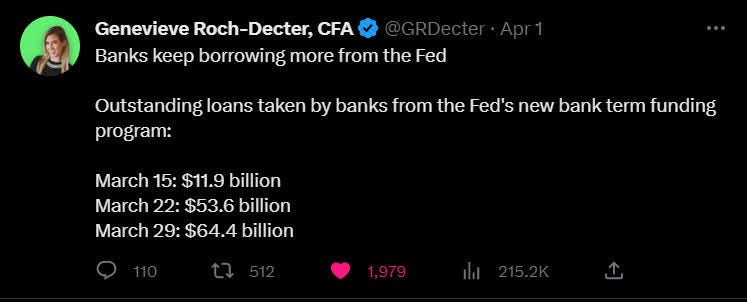Banking outlook - the impact to regional banks, commercial real estate and the global status of USD (03Apr2023)
(Update as of 04 Apr 2023 - about US default. More details in the following section)
Following the various banking issues, there is an interesting thread from Twitter user Mr David Sacks.
When the Fed spiked interest rates from ~0 to ~5% over the past year, it had 3 main effects:
1. Undercut value of bonds, especially long-dated bonds.
2. Made lending more expensive, particularly for large purchases like real estate that have to be financed.
3. Increased government borrowing costs.
These effects are just math and have to play out through the financial system. I think they will roughly correspond to the 3 stages of the financial crisis we’re in:
1. Small/regional bank crisis precipitated by unrealized losses on long-dated bonds.
2. Commercial Real Estate (CRE) crisis precipitated by credit markets seizing up for new loans and impairment of existing CRE loan portfolios (which are also unrealized losses).
3. Government debt crisis precipitated by spike in debt service costs at the Federal level, budget deficits at state and local level, and sovereign debt issues at international level.
We’re seeing the first stage play out now. The second and third stages are yet to come. Disclaimer: magnitudes are hard to calculate, and I make no predictions about the price of any asset. A lot depends on how government including the Fed reacts. I do not make trading recommendations.
My investing muse
Mr Sacks has listed 3 possible outcomes following the recent banking fallout. The first phase is currently happening as we see a surge in loans taken by the banking sectors as per the following screenshot.
Until the borrowing stops, it is hard not to have any concerns about the banking sector. With the Fed offering such loan facilities to prevent banking liquidity challenges, the Fed ends up taking more risks in the banking sector with default risks in play.
What is threatening the US is its history of debt ceilings risks that were fought in government. Though the US has never defaulted, such meetings have been happening often and at higher frequencies.
In fact, the US has defaulted 4x as per the article:
default on US government demand notes 1862
US government on its gold bonds 1933
Refusal to honor redemption of silver certificate paper dollars for silver dollars 1968
Breakaway from Bretton Woods Agreement 1971
Source: https://thehill.com/opinion/finance/575722-the-us-has-never-defaulted-on-its-debt-except-the-four-times-it-did/
Given the situation, apart from a fallout by the private sector, the US government’s lack of austerity could lead to the downfall of the US economy. With this, we can expect lesser countries to take up US bond issues. With the Federal government getting into a perpetual deficit, the higher interest rates of their bonds will lead to higher costs of borrowing. By the end of 2022, the US Federal government has incurred a deficit of over $1.3 trillion. This is expected to rise with the proposed bills. Come June, we can expect much drama between the 2 political parties before they finally compromise on a revised proposal. Would the excessive spending be joined by a lacklustre economy as GDP for 2023? In fact, there are various analysts who started to call out recessions by 2023.
The coming Q1/2023 earnings will be an important barometer. While there is always hope, let us be prepared to factor in the market going south (going bearish). The impact will be beyond the earnings but the outlook will weigh heavily on the market. Once fear hits the ground, it would lead to an economic slump though they should see the inflation easing further.
The US government needs to take a hard look at its spending. With USD’s global reserve currency status, the US domestic & international policies go beyond the shores of America. If the US continues to falter with the various challenges, it may be forced to relinquish its throne of global reserve currency. With more spending deficits, the US could only fund its spending by selling more bonds. Will there remain a market for these US government bonds given their economic outlook and internal turmoils? With more international contracts denominated in non-USD currencies, the US needs to demonstrate wise leadership and avoid petty geopolitical & economical spats. Let us build more bridges instead of walls.


Comments
Post a Comment